
Beneduce, Ann Keay illus. by Gennady Spirin. Joy to the World: A Family Christmas Treasury. Atheneum, 2000. ISBN 978-0689821134. pp. $
***
This newest collection of Christmas favorites has a spiritual slant, encouraging present day celebrators to remember the reverence and origins of the season. The editor has divided the book into sections that focus on symbols and traditions of Christmas, headed Star, Manger, the Gift Givers, the Tree and Christmas Everywhere. Selections include biblical verses and hymns, as well as stories, plays, poems, carols, and essays. Famous pieces include Yes, Virginia (there is a Santa Claus) by Francis Church, and Clement C. Moore’s The Night Before Christmas. Rich details include the history of Christmas pagents, the original St. Nicholas, and the scientific explanation for the bright star the Wise Men saw in the sky.
Unfortunately, the editor has chosen to offer abridgements of The Gift of the Magi by O. Henry, The Littlest Fir Tree by Hans Christen Andersen, and several other pieces that certainly would have been appropriate and welcome in their entirety. An editor’s note explains that though the pieces are abridged, all the words are the original authors, but the volume could easily have been extended to a still manageable 200 pages to include complete short stories and full-length chapters.
The collection has a multicultural slant, and not only in the Christmas Everywhere chapter, which explains traditions around the world. Within each chapter are stories and songs from England, Scotland and Germany, by Eskimos, African Americans, and Italians. More depth could have been achieved by including verses in other languages of songs such as O Christmas Tree and Silent Night.
The illustrations, gorgeous soft watercolors by Russian artist Spirin, are fascinating combinations of Italian Renaissance and old fashioned 1800s style. Subjects range from angels to Santas, children celebrating and shepherds watching their flocks. Full page spreads are few and far between, but all pages are decorated with intricate borders and designs. The jacket highlights the themes of the book in a lavish Christmas wreath with a large bow. The artist chooses to work with dark green and olive, maroon and dull gold, soft pale blue and pink, and creamy off white rather than vibrant colors, giving the book a nostalgic and solemn feel, rather than joyful. This is fitting, considering the emphasis on the true meaning of Christmas.
Those interested solely in the secular tales of Christmas may find the spiritual side too heavy-handed; pagans will be disappointed that barely a nod is given to the true roots of the Christian holiday, although the editor does mention that part of the importance of candles comes from the Hanukkah legend.
Two indexes, one for authors, one for titles, sorted by genre, are appended, and a full page of credits doesn’t include the sources for the facts presented in the introductions and preluding each piece.









